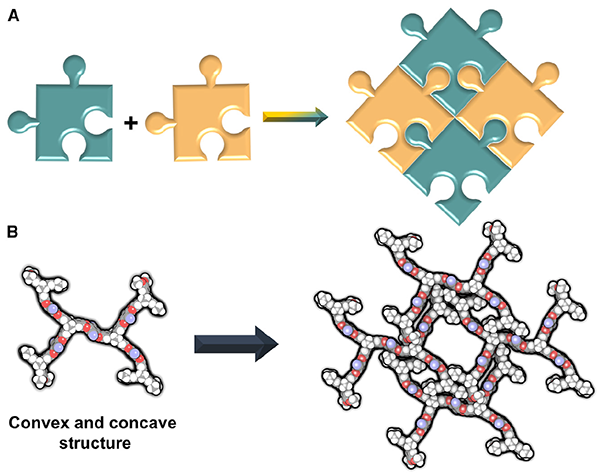Porous molecular crystals (PMCs), an intriguing type of crystalline porous material, are formed from discrete organic molecules via non-covalent interactions. Their unique properties, such as high solubility, self-healing capabilities, and structural flexibility, have recently captured substantial interest from the scientific community. However, compared to established networked porous materials like metal-organic frameworks (MOFs) and covalent organic frameworks (COFs), the relatively weak and less directional non-covalent interactions make PMCs less stable, presenting a major obstacle in crafting robust porous materials. Taking inspiration from jigsaw puzzles, a board game where interlocking pieces are assembled to form a pattern, Prof. ZHAO Yanchuan and his research team at the Shanghai Institute of Organic Chemistry of the Chinese Academy of Sciences developed a stable PMC through a method they dubbed "interdigitation-directed self-assembly". As described in their article in the journal Cell Reports Physical Science (https://doi.org/10.1016/j.xcrp.2023.101508), they utilized a propeller-shaped molecule, triptycene, recognized for its ability to generate porosity and unique concave-convex structure, as a building block for the construction of the molecular assembly. The team's findings, validated by single crystal X-ray diffraction, indicate that this self-assembly is driven by interdigitation and maintained by weak van der Waals interactions, functioning similarly to molecular jigsaw puzzle pieces. The resultant PMC has a Brunauer-Emmett-Teller (BET) specific surface area of 752 m2/g. The stepwise adsorption and substantial hysteresis of nitrogen sorption isotherms confirm the flexibility of this synthesized PMC, a fact further corroborated by structural simulations conducted in collaboration with Prof. ZHOU Wei from the National Institute of Standards and Technology (NIST) in the USA. In addition, this synthesized PMC exhibits outstanding thermal and chemical resilience, maintaining its crystallinity and specific surface area even after being immersed in highly concentrated NaOH, HCl, and boiling water. In preliminary application testing, this PMC demonstrated excellent Rhodamine B adsorption capacity in water (707 mg/g) and high CO2/N2 selectivity. This novel strategy of interdigitation-directed assembly offers significant potential for adaptation with a variety of building blocks. It could pave the way for the construction of porous architectures using weak van der Waals interactions, sparking further innovation and progress in the field. 
Figure. Comparison between assembling of jigsaw pieces (A) and porous molecular crystal via assembling jigsaw-like pieces (B). (Image by SIOC) ZHAO Yanchuan Ph.D. Professor Shanghai Institute of Organic Chemistry, Chinese Academy of Sciences Ling Ling Road 345 Shanghai 200032 China Tel: 0086-21-54925545 Email: zhaoyanchuan@sioc.ac.cn |


